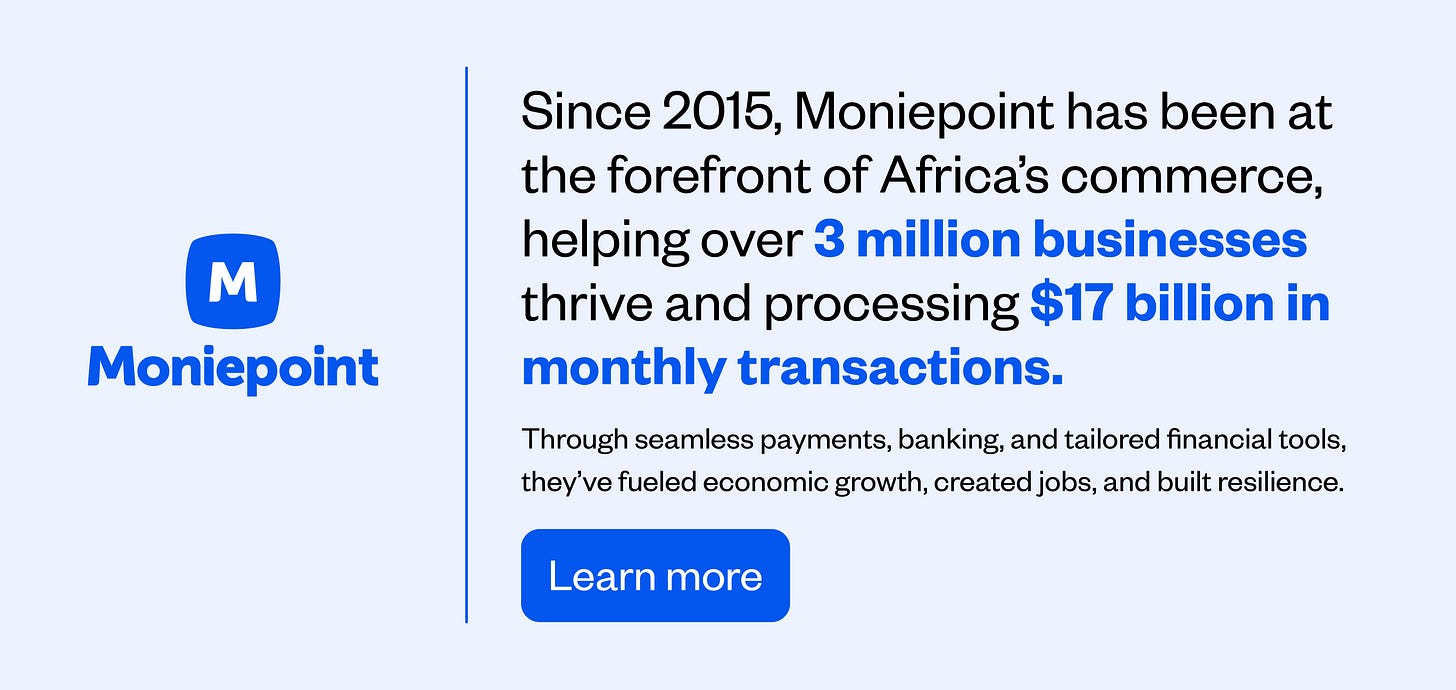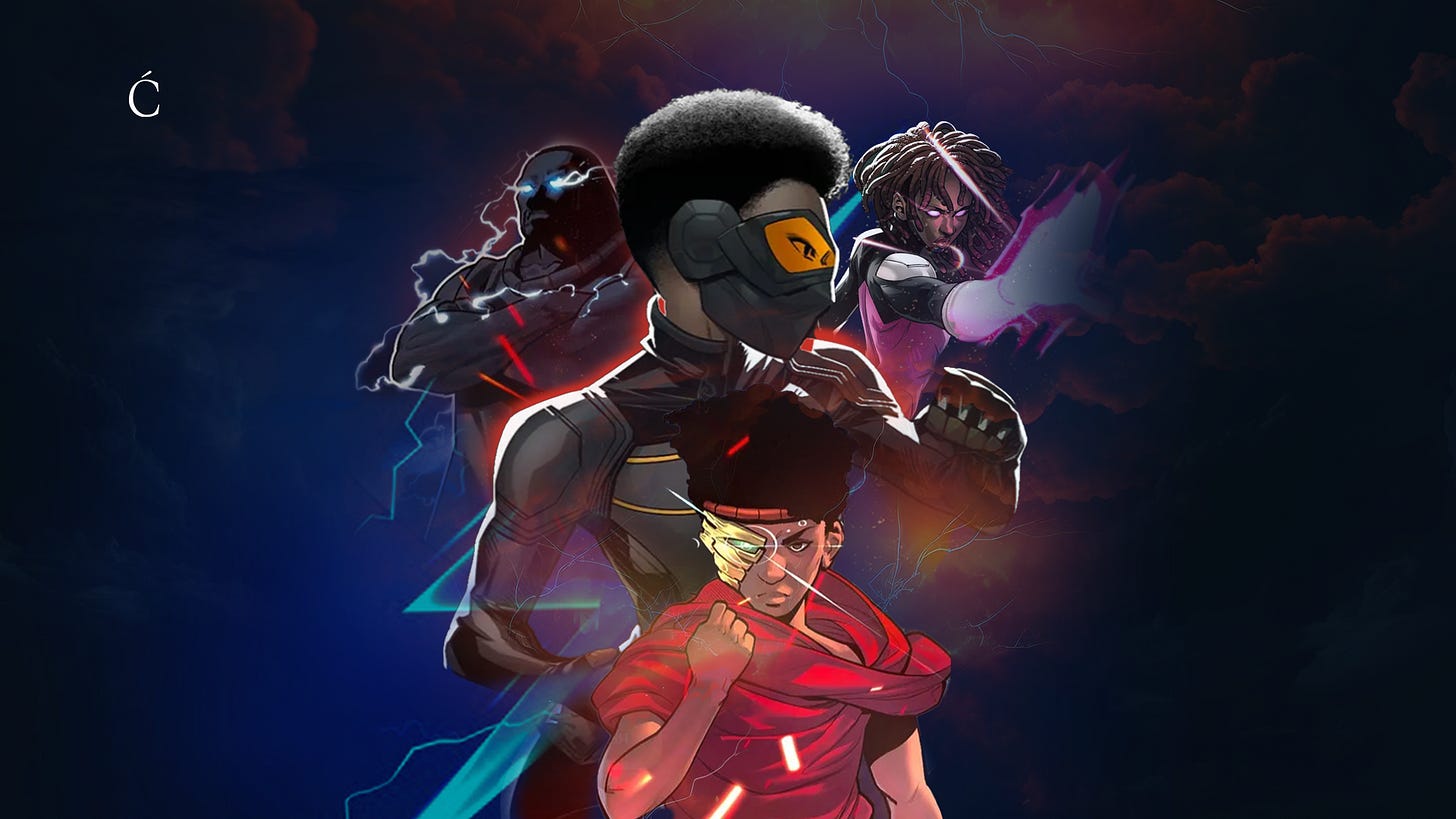Communiqué 73: The making of an African cinematic universe
Comic Republic’s 2023 Universal deal shows that the continent can produce a cinematic universe, but filmmakers need to think beyond standalone hits.
Presented by Moniepoint
Key Points
1. Plan for long-term storytelling: Successful cinematic universes require careful planning and continuity. African creators should design interconnected stories and characters from the start, focusing on ensembles or recurring themes that reflect shared cultural values, rather than relying on a singular main character.
2. Secure patient, multi-project funding: Investors should move beyond one-off film financing and support long-term franchise development. Co-productions and multi-film deals can help build sustainable universes, rather than expecting quick returns from standalone projects.
3. Build for a pan-African (and global) audience: To maximize reach, filmmakers should incorporate diverse African cultures, themes, and talent to ensure broad appeal. Grassroots marketing and regional engagement can help build loyal fan bases, while global partnerships can expand visibility.
Characters featured in this artwork are the intellectual property of Comic Republic.
1. Homemade heroes with global dreams
In August 2024, a YouTube video attracted attention for all the right reasons. A group of young Sierra Leonean teenagers, armed with an iPhone X and CapCut editing software, released a homemade superhero film under the banner of their self-created studio: the African Cinematic Universe. Their hour-long film, stitched together with rudimentary visual effects and unrelenting enthusiasm, has since racked up over 200,000 views. It might have remained a charming internet curiosity, were it not for one particular viewer: Idris Elba.
Elba, whose father hails from Sierra Leone, publicly praised the boys and pledged to support their filmmaking ambitions as part of a broader commitment to increase his investment in Africa’s creative industries. But the teenagers’ refreshingly earnest effort is far from the only attempt at cinematic world-building on the continent.
In 2023, Nigerian digital comic book publisher Comic Republic inked a $4 million deal with Universal Studios to develop a cinematic universe based on its roster of homegrown African superheroes. The deal marked the first time a global studio had bet on African IP that wasn’t a one-off production, but rather as the foundation for a cinematic universe.
But before that, Marvel’s Black Panther had proven the global appetite for African stories told with ambition and scale. Released in 2018, the film grossed over $1.3 billion, igniting pride across the continent and helping establish Wakanda as a cultural totem for the global Black community. But nearly seven years later, despite centuries of storytelling traditions, a vibrant film culture, and growing international attention, the continent remains absent from one of modern cinema’s most lucrative and influential formats: the cinematic universe.
2. In the beginning was Universal
The idea of a shared cinematic universe is not new. Long before Iron Man or Black Panther, there were Frankenstein and Dracula. In 1931, Universal Pictures launched what would become the first modern cinematic universe, starting with Dracula and Frankenstein, and later expanding to include The Invisible Man and The Wolf Man. These characters appeared in both standalone films and crossover titles, such as Frankenstein Meets the Wolf Man (1943) and House of Frankenstein (1944).
But the Monster universe was not successful. Story continuity was treated as optional, character development was inconsistent, and editorial choices often severed narrative threads rather than weaving them together. Universal had the right idea, but lacked the necessary infrastructure and discipline to sustain it.
The modern cinematic universe, by contrast, is a high-stakes exercise in precision and planning. And no studio has executed this better than Marvel.
3. Marvel’s long game
By the mid-2000s, Marvel had grown tired of licensing its characters to other studios. Despite the success of Spider-Man at Sony and the X-Men at Fox, Marvel was earning a fraction of the box office returns and had little creative control. In 2005, Marvel Entertainment raised $525 million through a credit facility with Merrill Lynch, betting it could produce its films.
Kevin Feige, then a junior executive who would later become its president, understood that while Spider-Man and Wolverine were locked up at rival studios, the core Avengers—Iron Man, Captain America, Thor, Hulk—were still available. More importantly, they existed in a shared comic universe that readers had followed for decades. Feige’s bet was simple: that audiences would care not just about characters, but about continuity. That the thrill of watching separate storylines converge would be just as powerful as the individual storylines themselves.
Marvel Studios launched Iron Man in 2008, a standalone film that grossed over $580 million. Later that year, The Incredible Hulk was released to rave reviews and grossed $265 million at the box office. But the larger payoff was still years away. In 2009, Disney acquired Marvel for $4 billion. At the time, the total box office revenue from Marvel’s IP (both films produced in-house and those licensed) was $4.5 billion. Since then, Marvel’s Cinematic Universe (MCU) has gone on to earn over $25 billion from 21 interconnected films, making it the highest-grossing film franchise in history.
Marvel’s success sparked a rush of copycats. Some succeeded. Godzilla, created by Japan’s Toho Studios in the 1950s, made a comeback in Legendary Studios’ MonsterVerse, anchored by Godzilla (2014), Kong: Skull Island (2017), and Godzilla vs. Kong (2019), which collectively grossed over $2.5 billion.
But most attempts have failed. Warner Bros. attempted to establish a King Arthur universe with The Legend of the Sword (2017), but audiences barely noticed. Sony’s Robin Hood (2018) was meant to launch spin-offs for each of the Merry Men, but flopped before it could even start. Universal’s infamous “Dark Universe,” heralded by The Mummy (2017) starring Tom Cruise, lost the studio $150 million.
Still, the promise of a cinematic universe in which stories, characters, and fan bases could compound in value remains tantalizing.
As one screenwriter put it in a conversation with media scholar Henry Jenkins, quoted in The Conversation, “When I first started, you would pitch a story because without a good story, you didn’t really have a film. Later, once sequels started to take off, you pitched a character because a good character could support multiple stories. And now, you pitch a world because a world can support multiple characters and multiple stories across multiple media.”
Despite Africa’s rich well of mythology, folklore, and lived experience, its filmmakers have yet to launch an actual cinematic universe. The reasons are not creative, but structural and cultural.
4. Why Africa has no cinematic universe yet
First of all, the business model behind cinematic universes—a long game of multi-project financing, coordinated timelines, and audience development—is largely incompatible with how investment works in contemporary African filmmaking.
Funding in Africa’s film industries is primarily short-term and project-based. A production secures capital to make one film, not to develop an interconnected trilogy or expand into a spin-off series. Investors want quick returns and lower risks. Few are willing to wait the five to ten years it might take to nurture an entire universe of stories.
Also, the very concept of a superhero, which most cinematic universes are built around, doesn’t always resonate in the same way. While Western narratives have long championed the lone hero, someone who rises above their peers, usually burdened with unique powers and a singular destiny, African societies tend to prioritize the collective. Identity is often rooted in ancestral lineage, communal legacy, and interdependence rather than individualism.
“Unlike Hollywood, which has stayed on the blockbuster superhero sci-fi format, we mostly produce melodramas. We don’t even have the technology to properly produce sci-fi,” Dr. Shaibu Husseini, the Director General of the Nigerian Film and Video Censors Board (NFVCB), told Communiqué.
But a cinematic universe does not have to be based on superheroes. It only has to include films that share the same fictional world, characters, and storylines.
African filmmakers can achieve this by:
I. Planning for continuity
Plan interconnected characters and worlds from the start. Create recurring protagonists that reflect African communal values, think ensemble heroes instead of lone crusaders. Local franchises prove the model works: Charles Okpaleke’s Play Network Africa attempted it with three Nollywood remakes—Living in Bondage: Breaking Free, Rattlesnake: The Ahanna Story, and Nneka the Pretty Serpent—with all three appearing in the top 100 highest-grossing Nigerian films.
Ayo Makun’s “Akpos” comedies (30 Days in Atlanta and its sequel A Trip to Jamaica) drew massive audiences by following the same hero on new adventures in totally different films. Likewise, Marvel’s MCU built audience loyalty by weaving standalone films into a cohesive timeline. This approach turns isolated hits into a self-sustaining franchise, encouraging viewers to follow each new chapter.
II. Financing for the long game
African filmmakers can overcome budget constraints by pooling resources through co-productions. Producers can also leverage rising investor interest to finance multiple films, rather than the singular project that is the norm. In May, BRS Studios announced a slate of three movies to be released this year, all of which were financed by MBO Capital. While the films do not form a cinematic universe, other filmmakers can adopt a similar model to secure investment deals and create their cinematic universes.
III. Creating for a pan-African audience
Think continent-wide from day one. Producers should assemble creative and production teams from multiple regions across the continent to ensure broad cultural appeal. They should address themes and settings that span African experiences (such as urban life, diaspora, and folklore), so that audiences everywhere feel represented. They can buttress this with grassroots marketing and regional premieres to generate buzz. Then, iterate based on audience feedback: monitor which characters or settings resonate, then expand those threads in sequels or series.
Across the continent, there are already stories with the depth and scope to anchor full-fledged cinematic universes. Tomi Adeyemi’s Children of Blood and Bone trilogy, inspired by Yoruba mythology, has been optioned by Paramount. And Comic Republic, with a vast roster of African superheroes and mythic figures, is actively developing its universe under a global studio partnership. These examples show that the seeds have already been planted. What’s needed now is the will to nurture them.
African filmmakers can craft cinematic universes that rival those of Hollywood. The next Wakanda doesn’t have to be imagined by outsiders. It can be built right here.





This was a fun read.